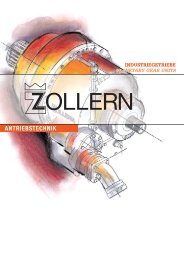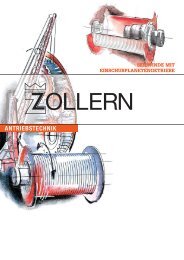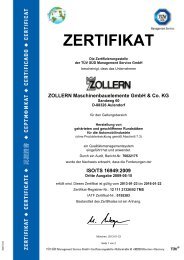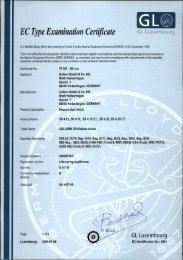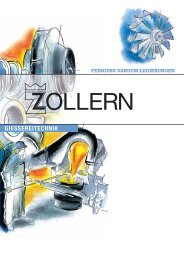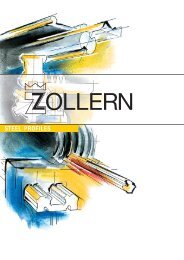FOUNDRY TECHNOLOGY - Zollern
FOUNDRY TECHNOLOGY - Zollern
FOUNDRY TECHNOLOGY - Zollern
Create successful ePaper yourself
Turn your PDF publications into a flip-book with our unique Google optimized e-Paper software.
Toothing<br />
The rough and finish casting of special toothing arrangements<br />
of all different types can be economically performed using the<br />
investment casting technique, in particular using heavy-duty,<br />
non-machinable materials. Applications include Gear and<br />
clutch toothing, serration, internal gears and gear-type profiles<br />
which cannot be machined using the generation grinding<br />
method, bevel and chain wheels, worm gear wheels. If the<br />
investment casting tolerances are not sufficient for the pitch<br />
and diameter, the casting must be subsequently machined,<br />
for example by grinding.<br />
Threads<br />
Threads are only included in the casting if the investment<br />
casting tolerances are sufficient for the pitch and profile. This<br />
means that only the following special cases can be considered<br />
for casting :<br />
• Interrupted threads, e.g. for bayonet catches and quickaction<br />
couplings;<br />
• Threads which mate with materials such as rubber or plastic<br />
• Coarse circular or trapezoidal threads;<br />
• Threads of alloy which are important to examine whether it<br />
might not be possible to either avoid their use by a modification<br />
of the design, or to carry out subsequent grinding.<br />
The modules for which casting is still possible depend on the<br />
size of the casting and the type of material. The following<br />
general rule applies: m ≥ 1.0 mm for FE, I, Co based alloys,<br />
m ≥ 0.5 mm for Al and Cu based alloys.<br />
In the case of serration and similar types of toothing, the teeth<br />
which become finer towards the middle should be recessed<br />
at the places at which the pitch falls below the following<br />
values:<br />
t = 1.0 mm with Fe, Ni, Co based alloys<br />
t = 0.5 mm for Al and Cu based alloys<br />
Notch effects, radii<br />
Not only the designer but also the caster is anxious to avoid<br />
notch effects, as sharp-edged notches (heating edges) interfere<br />
with the casting process. A casting with larger radii<br />
demon strates a less marked stress gradient, making it more<br />
functionally reliable. The ‘rough’ surface of an investment<br />
casting demonstrates the same notch insensitivity as a finish<br />
machined surface.<br />
Unfavourable<br />
Cooling fins<br />
Cooling fins should have cross-sections wich taper towards<br />
the outside; this not only improves casting performance but<br />
also the heat flow.<br />
Favourable<br />
R<br />
Heating edges<br />
Material: Al or Cu based alloy<br />
Possible<br />
Favourable<br />
R<br />
R<br />
R<br />
R<br />
R<br />
R<br />
R<br />
INVESTMENT CASTING



